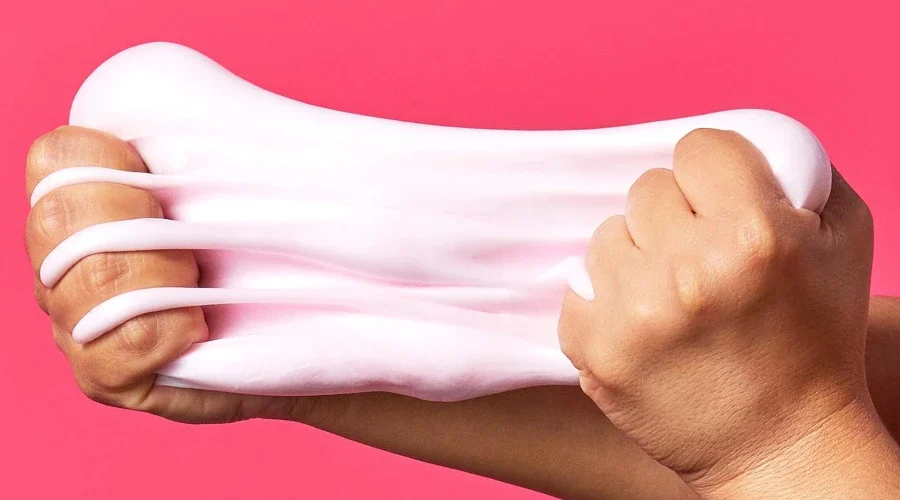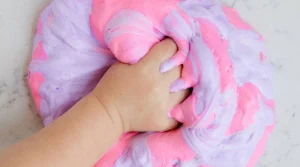
What Do Slime Toys Do? The Science and Learning Behind Slime
Curious about slime toys? Learn what they do and how they help children learn, create, and develop essential skills naturally.
#1 Toys Manufacturer in China. WhatsApp: +86 180-0088-4063. Email: [email protected]
#1 Toys Manufacturer in China. WhatsApp: +86 180-0088-4063. Email: [email protected]

Whether it’s a freshly made batch or one that’s been stored a while, sticky slime can make handling difficult. This blog explores why slime becomes sticky, which factors can reduce stickiness, and simple tricks to achieve that perfect, manageable texture.
Sticky slime might seem annoying, but it happens for some interesting reasons rooted in its ingredients and the environment.
>> Butter Slime vs. Regular Slime: What’s the Difference?
The stickiness of slime comes from the chemical bonds formed between the ingredients.
Most slimes are made by combining glue, which contains polymers, with an activator, which links those polymers together. The result is a stretchy, moldable substance. However, if these polymer chains don’t bond in the right way, the slime can get extra sticky.
Moisture levels in the air also play a big role. Slime can absorb humidity, making it softer and stickier over time. This is why slime feels different on a rainy day than on a dry one.
Temperature matters too. Warmer environments can break down slime’s bonds, leading to a stickier feel.
Finally, the ratio of glue to activator is critical—too little activator, and the slime doesn’t set; too much, and it hardens.
Each slime ingredient affects the texture differently.
| Ingredient | Role in Slime | Effect on Stickiness |
|---|---|---|
| PVA Glue | Primary base for slime | Provides a smooth consistency; naturally sticky |
| Activator | Links glue polymers, creating slime texture | Reduces stickiness; type of activator affects firmness |
| - Borax Solution | Firm activator | Yields firmer, less sticky slime |
| - Saline Solution | Softer activator | Produces softer slime; may require more to reduce stickiness |
| - Liquid Starch | Mild activator | Offers moderate firmness with reduced stickiness |
| Water | Softens slime | Can make slime more adhesive if added excessively |
| Mix-ins (e.g., Shaving Foam) | Adds texture and volume | Softens and lightens slime; may increase stickiness if overused |
Adjusting slime’s texture doesn’t have to be complicated. Here are effective methods to make slime less sticky without losing its stretchy, satisfying quality.
One of the simplest ways to fix sticky slime is by adjusting the amount of activator.
Activators, like borax solution, saline solution, or liquid starch, help reduce stickiness by strengthening the bonds between the glue molecules.
For saline solution, start with 1-2 drops at a time, kneading the slime between each addition to check the texture. Borax solution is slightly stronger, so adding just a few drops may be enough.
Liquid starch is milder, allowing for slightly larger amounts without over-firming the slime. Adjusting slowly helps find the balance between sticky and too firm.
>> The Science Behind Floam Slime: What Makes It So Addictive?
Cornstarch and baking soda are useful for balancing slime’s moisture. These powders absorb some of the excess water in slime, which can contribute to its sticky feel, especially in humid environments.
Both options work well for creating a smoother, less tacky slime, ideal for handling without sticking to fingers.
Lotion or baby oil can be added to slime for a softer, silkier texture.
Lotions work well because they’re water-based and absorb easily, helping reduce stickiness without making the slime too slippery. Start with a pea-sized amount, kneading it in thoroughly before adding more.
Baby oil, being oil-based, adds a different effect. It helps slime slide more easily and leaves a smooth, almost buttery texture. However, use it sparingly—a few drops should be enough.
Too much oil can make the slime overly soft and harder to manage, so it’s best to add little by little, checking the feel as you go.
Sometimes, despite best efforts, slime can still feel sticky. These quick adjustments can help achieve the ideal texture and keep slime fun to handle.
Environmental factors like temperature and humidity can greatly affect slime stickiness.
High humidity, for instance, can add moisture to slime, causing it to cling more. On the other hand, dry air can make slime firmer or even crumbly. Storing slime in a cool, dry spot, ideally in an airtight container, can help maintain the right balance.
If slime becomes stickier on a humid day, consider placing it in the fridge for 10–15 minutes. The cooler temperature can make the slime easier to handle, offering a temporary fix until conditions change.
Sometimes, slime starts to feel sticky again during play, even if it seemed perfect at first. Fortunately, simple ingredients can make it manageable on the spot.
For a quick fix, sprinkle a small pinch of cornstarch over the slime and knead it in until it feels balanced. Cornstarch absorbs extra moisture without adding stiffness.
Alternatively, adding a drop or two of activator, like saline solution or borax, can restore the slime’s consistency without hardening it. These quick fixes work well, allowing for easy adjustments to keep slime play enjoyable.
>> Formulating Borax Free Slime: Best Practices for Manufacturers
To get slime that feels smooth and balanced rather than sticky, the ingredients you choose are essential. High-quality materials can make a significant difference in achieving the right consistency and stability.
The type of glue and activator you use is crucial.
PVA glue, commonly found in brands like Elmer’s or AmazonBasics, offers strong bonding properties that lead to a less sticky slime. The consistency of PVA glue creates a stable structure, providing a firm yet flexible texture.
For activators, consider reliable options like borax solutions, saline solution, or liquid starch.
Saline solution, for example, contains both boric acid and sodium borate, which react well with PVA glue to form a consistent slime texture. These activators work well across a variety of recipes, helping create non-sticky slime that holds up during play.
Adding a few extra ingredients can enhance the slime’s texture, creating a smoother feel.
Soft clay, often used in DIY butter slime, can reduce stickiness while adding a spreadable texture. Brands like Daiso’s soft clay are popular for this purpose.
Other additives, like shaving foam, add fluffiness and make slime feel light and airy.
The foam’s texture also helps balance moisture levels, resulting in a more pleasant, less sticky feel. These ingredients can also increase elasticity, so your slime stretches rather than clings—perfect for making the experience more enjoyable and hands-on.
Proper storage is key to maintaining the ideal texture of slime. When stored correctly, slime can keep its smooth, non-sticky consistency for longer periods.
The right storage container is essential for keeping slime from becoming sticky.
Airtight containers, such as plastic jars or resealable bags, work best. These containers help keep out air and moisture, preventing the slime from drying out or absorbing too much humidity, both of which can lead to stickiness.
Additionally, avoid storing slime in places exposed to heat or direct sunlight, as this can cause the moisture in the slime to evaporate, making it sticky. Instead, keep slime in a cool, dry place, such as a closet or drawer, where the temperature remains stable.
>> The Science Behind Butter Slime Unique Ingredients
Slime can sometimes become sticky after being stored for a while.
To restore its ideal texture, simply add a small amount of activator, such as saline solution or borax solution, and gently knead it in. This will help restore the consistency and reduce stickiness.
If the slime is too dry, adding a little water can help rehydrate it.
Be sure to add small amounts at a time to avoid over-saturating the slime. For added smoothness, consider kneading in a bit of lotion or soft clay, which can help restore elasticity and prevent further stickiness.
Achieving the perfect, non-sticky slime comes down to balancing ingredients, environmental factors, and proper storage. By adjusting activator levels, using the right additives, and storing slime correctly, you can maintain a smooth, ideal texture for longer play sessions.
The type of glue you use plays a significant role in slime's texture. PVA glue, for example, tends to create a more flexible and less sticky slime compared to other types. Choosing a high-quality glue ensures the right balance of viscosity, making it easier to adjust consistency without making the slime too sticky or too firm.
Yes, environmental factors like humidity and temperature can impact slime’s texture. High humidity can cause slime to absorb moisture from the air, making it stickier. Storing slime in a cool, dry place can help maintain its ideal consistency, preventing it from becoming too tacky or overly soft.
If slime becomes sticky during production, try adding a small amount of activator (such as borax solution or saline). Gradually knead the activator into the mixture until the slime reaches the desired consistency. Be careful not to add too much at once, as it could result in overly firm slime.
To prevent slime from becoming too runny, ensure the correct ratio of ingredients. Using too much water or activator can cause the slime to lose its structure. Adding a thickening agent like cornstarch or a small amount of shaving foam can help stabilize the texture, making it less liquid-like.
Yes, you can add a small amount of lotion or baby oil to the slime before storing it. These ingredients add moisture without making the slime too sticky. Just a small amount can keep the slime soft and pliable, maintaining its texture until it’s ready for use again.
More Related...

Curious about slime toys? Learn what they do and how they help children learn, create, and develop essential skills naturally.

Uncover the science of thermochromic slime — where chemistry meets creativity through playful, color-changing reactions.

Uncover why slime play is more than fun—7 benefits include sensory learning, creativity, and fostering emotional and cognitive development.

Understand how stress-relief putty helps manage anxiety, improve focus, and promote relaxation through tactile sensory play.

Our team will answer your inquiries within 48 hours.
Copyright © 2025 GuangDong AKIA Technology Co,. Ltd. All Rights Reserved